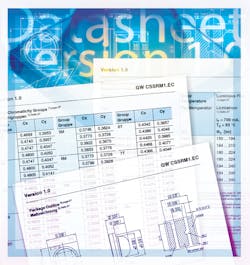The SSL industry has struggled with the lack of standardized methods for characterizing LED performance, but as JIANZHONG JIAO explains, the IES LM-85 standard provides comprehensive guidance as to how LED manufacturers derive specifications.
In solid-state lighting (SSL) applications today, LEDs that require heat sinking in normal operating conditions are categorized as high-power LEDs. As with all LEDs, the photometric characteristics of high-power LEDs — such as luminous flux, chromaticity, and temperature or current dependency — are critical pieces of information that require consistent and reliable methods of measuring and verifying by LED manufacturers and users. The IES LM-85 standard defines LED measurement and characterization methodology including accounting for realistic temperatures at which the components operate in SSL products.
Part of the problem with characterizing LEDs accurately is attributed to the components' high sensitivity to thermal operating conditions. Measuring their photometric characteristics has been difficult. Although high-power LEDs have been available for years, the industry is still lacking standards that can be used by manufacturers and users to obtain reproducible results. Often, LED manufacturers provide the high-power LED's photometric information in the product's datasheet, but noticeable differences may arise when users compare their own measurements to the datasheet.
In today's practice when performing photometry, manufacturers typically use a pulse mode to operate high-power LEDs without a heat sink. Using the pulse mode, it is assumed that the LED's junction temperature is not raised, and it is the same as the ambient or room temperature — generally 25°C. Therefore, many published LED datasheets list the LEDs' photometry information with junction temperatures of 25°C.
Pulse and DC mode
In real-world applications, high-power LEDs are usually operated in DC mode, and the LEDs' junction temperature can be significantly higher than 25°C. Because of an LED's thermal behavior, the light output is reduced at these higher temperatures. To assist users, LED manufacturers usually provide the thermal characteristics, or how an LED's photometric values change, over temperature. However, because LEDs are binned for their photometric characteristics at 25°C in most cases, the data for higher operating temperatures may not be directly addressed in the datasheets.
There have been no standardized methods for measuring high-power LEDs, in particular at these higher temperatures. The IES Testing Procedures Committee (TPC) formed a working group several years ago that started to develop a standard to address this industry need. In 2008, the National Institute of Standards and Technology (NIST) published a study on high-power LED photometry using DC operation. In the NIST's report, a testing procedure was proposed, and a comparison to the pulse-operated measurement results was also provided.
Based on the NIST study and the SSL industry's current practice, the IES working group drafted the LM-85 standard, titled "Approved method of electrical and photometric measurement of high-power LEDs." The scope of LM-85 states: "this document describes the procedures in performing accurate measurements of total luminous flux, total radiant flux (optical power) and total photon flux, electrical power, luminous efficacy, color quantities, and wavelength characteristics of high-power LEDs. The method covers LED packages and applies to laboratory measurements. The document does not cover LED arrays or modules, LED light engines, LED lamps, and LED luminaires; it does not cover AC driven LEDs, and does not apply to measurements in LED manufacturer's production control or relative measurements of LED thermal characteristics."
Thermal consideration
It is well known that the optical characteristics of LEDs essentially depend on their junction temperature; thus, setting to a predefined junction temperature is the basis for obtaining reproducible results universally for all types of LEDs. A defined temperature enables the industry to establish equivalence of results between the pulse-mode method tests performed by LED manufacturers, and the DC-mode tests performed by LED users.
LM-85 has been written using the basis of junction temperature set at room temperature of 25°C, or at any given elevated temperature. LM-85 provides detailed procedures for testing LEDs using DC operation and pulse operation with the intent of obtaining the LED's absolute photometry values. For pulse operation mode, it further describes how the measurements take place with a single pulse or continuous pulse operation.
LM-85 specifically states the ambient temperature and thermal stability recommendations while measuring photometric characteristics, as both ambient temperature and LED thermal stability are important for measurement accuracy. The ambient temperature is particularly critical if the junction temperature is set using the ambient temperature. In this case, the ambient temperature should be controlled in a tight tolerance range. If the ambient temperature is not in the required range, corrections should be made from the temperature dependence of the LED's characteristics so that the results show the values at the required ambient temperature condition.
For the case of an elevated temperature where higher-junction-temperature-associated light output needs to be measured, the LEDs must reach a thermal equilibrium and stability at an elevated temperature before the measurement takes place, whether a thermal chamber or controlled heat sink is used to raise the temperature. For the thermal chamber approach, LM-85 suggests the thermal stability time period be a minimum of 30 minutes. For the controlled heat sink approach, depending on the thermal capacity or size of the LED package, the thermal stability time may be only a few minutes.
DC characterization
The DC-operation-mode measurement method essentially requires that the measured LED be placed on an active cooling device or a temperature-controlled heat sink such as a thermoelectric cooler (TEC). Depending on the power level of the TEC, when it is set for a given temperature such as 25°C, the LED should reach a state of thermal equilibrium where LED junction temperature is the same as its case or board temperature in a short time period. When such thermal equilibrium is reached, a DC current as a step pulse or a short pulse is applied to the LED. Then the LED's instantaneous forward voltage is measured immediately after the LED is electrically stabilized and before the LED is heated up.
When the LEDs are heating up, the reaction of light output reduction can be noticed in a few microseconds, and in turn its forward voltage also changes. The LM-85 DC measurement procedure keeps the LED operating in a specified DC current as the LED is heating up, adjusts the TEC power to lower its temperature so that the LED's forward voltage is kept equal to the initial or instantaneous forward voltage, and thus maintains the same LED junction temperature as the LED reaches thermal equilibrium, possibly 25°C. As the TEC power and LED forward voltage control continues, the measurements of any optical (radiometric, photometric, and colorimetric) quantities of the LEDs are taking place. The measured results are the values at a junction temperature of 25°C.
While using a temperature controlled heat sink or TEC, the LED junction temperature can be set at a higher temperature; thus, following the DC operation testing procedure listed in LM-85, the higher junction LED photometry information can also be obtained. If the LED forward current is fixed for all temperatures, this measurement can provide users with direct measurement results for how LED light output changes relative to temperature.
Pulse-mode characterization
The single-pulse-mode measurement method, which is widely used by LED manufacturers, applies a one-shot current pulse to the LED then quickly makes an optical measurement during the pulse. In this operation mode, in principle, the junction temperature of the LED is taken to be approximately the same as the ambient temperature, assuming the pulse is short enough. However, optical measurements require a certain time duration. If the measurement takes too long, the LED junction temperature can increase significantly.
LM-85 requires the optical measurement of LED emission to be within the duration of the pulse. Therefore, the pulse width must be determined by the speed of the photometric or spectroradiometric instrument used. The LED junction temperature will increase significantly during the duration of the current pulse. LM-85 recommends the increase of junction temperature or the resulting decrease of the measured LED light output should be evaluated and corrected. The measurement procedures for the signal pulse method recommended in LM-85 require a few steps:
• Stabilize the temperature of the LED to the desired junction temperature.
• Apply the signal current pulse to the LED and wait for the settling time recommended by the LED manufacturer (typically 5 ms).
• Start and complete the optical and electrical measurement within the time duration recommended by the LED manufacturer (typically within 20 ms).
Continuous pulse-mode measurement is also a current industry practice. In this method, continuous current pulses with a very small duty cycle at a certain frequency are applied to the LED, and optical measurements are made for the time-averaged signal, similar to the DC operation measurement. Because the duty cycle is very small, optical measurement errors due to the increase of junction temperature are negligible. LM-85 recommends a duty cycle of 1% or less. The measurement procedures for the continuous pulse method recommended in LM-85 include the following steps:
• Stabilize the temperature of the LED to the desired junction temperature.
• Apply the continuous pulse current and wait for a certain settling time, such as 100 ms.
• Perform the optical and electrical measurements for a certain duration of integration time or read a time-averaged signal in a steady condition.
LM-85 states that the integration time shall be an integer that is a multiple of the period of the pulses to avoid errors due to the timing of integration. Then, standard practice requires that you divide the measured photometric or radiometric values by the current duty cycle.
For both pulse operation modes, an LED's light output at a higher junction temperature can also be measured using either a thermal chamber or a controlled heat sink. The LEDs being measured at the higher and stabilized temperature are to follow the procedures for either single- or continuous-pulse measurement. A correction factor can be used for LED packages with very high thermal resistance if the pulse mode may cause the temperature to rise at the LED junction and, in turn, cause a reduction in light output. LM-85 lists examples of an LED thermal model when the LED thermal behavior is known by which the appropriate correction factor can be calculated.
The LM-85 standard, "Approved method of electrical and photometric measurement of high-power LEDs," sets a basis for measuring high-power LEDs with consistent, reliable, and repeatable procedures so LED users can obtain directly measured photometric results that closely correlate with LED datasheet information provided by LED manufacturers. In implementing a standard procedure such as LM-85, the absolute photometry of a high-power LED can be established. In doing so, just as for any other light sources such as bulbs, accurate rated or standard LEDs eventually can be established and become traceable to NIST.
DR. JIANZHONG JIAO, director of regulations and emerging technologies at Osram Opto Semiconductors, Inc. is an internationally recognized lighting expert. He has been actively involved in LED and SSL standard development activities. He serves as the past chairman of the SAE Lighting Committee, past chairman of NGLIA, past chairman of the NEMA SSL Technical Committee, active member of IESNA Testing Procedure Committee, Roadway Lighting Committee, and Computer Committee, ANSI SSL Working Groups, Standard Technical Panel of UL8750, standard committees in IEEE, CIE USA, SEMI, JEDEC, and other organizations. He can be reached at [email protected].








